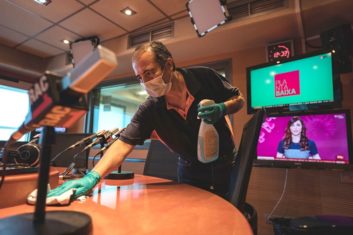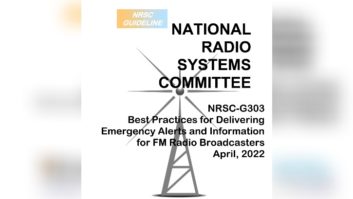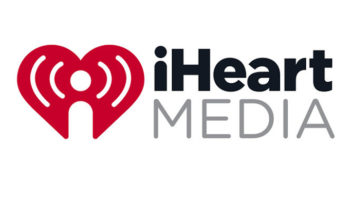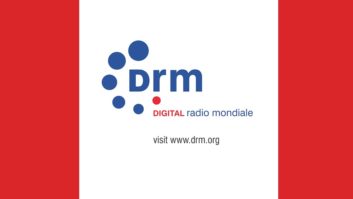
Broadcasters in the United States are implementing a number of COVID-19 safety protocols as they resume radio station operations. But the process has been both tentative and uneven, given the dynamic national health and economic situation.
Industry leaders say safe return of employees is their priority as they evaluate when to reopen facilities and reimagine what new workplaces will look. Many broadcasters closed facilities at the onset of the coronavirus, and it’s very likely many will continue to have some employees work from home, according to those familiar with the situation.
Return-to-work scenarios shared by several executives with Radio World are wide-ranging and include safety protocols like social distancing along with mitigation efforts to prevent further virus outbreaks.
One challenge facing broadcasters is the varying reopening requirements set by local jurisdictions. As of early July some parts of the country had reopened even as other states were seeing spikes in the number of COVID-19 cases.
Many broadcasters are following the guidance of the Centers for Disease Control and Environmental Protection Agency for cleaning and disinfecting workplaces and other common areas. Radio station lobbies remain closed to the public in many cases, according to sources with direct knowledge of discussions.
Like a number of companies, Cox Media Group, which operates 54 radio stations in 10 markets, declined to discuss its specific re-entry approach for this story. However, a spokesperson said the company is moving ahead with caution. “We are doing everything we can to create a safe work environment and ensure our employees’ well-being.”
Practical Concerns
The pandemic processes described by those who spoke with us include drastic measures like limiting free movement of employees inside buildings, avoiding the use of large meeting spaces, and even limiting the return of employees considered at high risk of contracting the virus. In many cases sales people will continue working off-site.
Those new work routines for employees are still being carved out, with new guidelines being adopted as office spaces and studios are realigned. Work models are still being fine-tuned by many large broadcast groups but work from home for some employees is expected to be extended.
A top-market public radio executive noted that companies not only must create their own rules but abide by those of the buildings where they lease space. This may raise additional issues involving maximum building occupancy, new “traffic patterns” such as one-way stairwells, and additional security card readers to support those patterns.
Also, if more air and IT staff are expected to work permanently from home, their employers may need to provide those homes with uninterruptible power supplies for conditioning and backup power — and have plans in place for “passing the mic” to backup talent or support people if the home is hit by an extended power outage.

Longer-term, a high-ranking corporate executive at one major radio group foresees a major shift to more centralized broadcast operations.
“It is pretty clear that corporate radio is trending to more centralized operations in general, similar to what iHeartMedia is doing. If anything, this pandemic proved remote operation could be achieved much more easily than first thought,” he said. “I think we will generally see facilities with fewer people and more on-air content being generated centrally instead of locally.”
iHeartMedia announced earlier this year plans to create AI-enabled Centers of Excellence in order to consolidate some operations at its radio stations, according to those familiar with the development.
Toolkit
NAB Executive VP and Chief Technology Officer Sam Matheny said radio CEOs and other senior leaders he has spoken to have been pleasantly surprised at how well the shift to remote work has gone.
“In many cases 75 to 80% of the workforce is now, or was at one point, remote. The technology and engineering is there to enable it,” Matheny said.
[Related: “New Ebook Explores Broadcasting From Home”]
For some broadcasters, returning employees to the office may sound easy, but working from there could be hard, he said.
“I think a really important thing broadcasters can do right now is to have a plan for what happens when someone in their organization is diagnosed with COVID-19. This is especially true for stations that operate with a small staff where a single infection could cause a major disruption due to quarantine of multiple employees,” Matheny said.
The NAB has a Coronavirus Toolkit that offers station operation resources, educational resources and a link to the CDC’s guidelines on reopening.
“When it comes to returning to the office, the size and configuration of the broadcast facility and team will drive the physical considerations,” Matheny said. “Face masks are a major area of focus and were deemed the most needed Personal Protective Equipment item by broadcasters and others in the communications sector for critical employees.”
Hand sanitizer, gloves and supplies for regular cleaning of studio or other shared equipment are critical, Matheny said. “And an item that I believe is unique to broadcasters is the increased need for changeable microphone screens,” he said.
Other strategies being considered by broadcasters to maintain social distancing include barriers, modified work hours, alternating days in the office as well as people working remotely, Matheny said.
Cleaning crews will be necessary since wiping down all surfaces will be critical, he said. “And even staggered building entry times might be necessary since using elevators will be difficult while maintaining social distancing.”
Limited Occupancy
One engineering executive at a major broadcast group said remote work for his company will continue for some time.
“Occupancy of air studios will be limited based on size,” the source said. “All air staff who are in the building will be at least six feet apart with clear dividers installed where necessary.”
Break rooms are likely to remain closed for some time, he said, and companies will do regular cleaning and sanitizing of touch points throughout broadcast facilities.
Many broadcasters are operating with fewer employees after furloughs; the industry has also seen recent job cuts that predated or were not specifically tied to the health crisis. One open question is how many such jobs might be recovered.
Big and small broadcast groups tell Radio World they are facing similar economic and operational issues during the pandemic.
Smaller and medium-sized groups are affected as much as the biggest ones. Art Sutton, president/CEO of GA-Carolina Broadcasting, said his company furloughed nine employees and closed stations to the general public. “We won’t consider bringing our employees back before July 31, when the federal government’s $600 weekly unemployment benefit expires,” he said.
The broadcaster, which has 16 radio stations across five small and medium markets, saw major revenue declines the past several months.
“Since we are operating with fewer people, that helps to offset our revenue declines of 5% in March 2020 compared to March 2019,” he said. Sutton reported a “brutal” 33% decline in April, 20% in May and a projected drop in June of 15-16%.
What’s your own experience? Email [email protected] with “Letter to the Editor” in the subject field.







